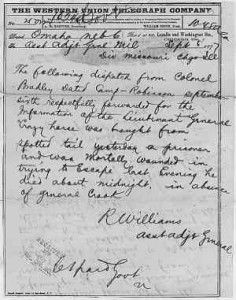Today we recall and venerate Crazy Horse – the visionary, legendary, almost mythical Native American warrior leader of the Oglala Lakota Sioux – who was betrayed by friends then assassinated in custody on this day in 1877. Fucked over by the white man and betrayed by his own shattered people, Crazy Horse remains one of the most potent symbols of White America’s brutal annihilation of its aboriginal peoples; its racially biased, WASP-o-centric policy of Manifest Destiny apparently justifying a merciless expansion of its western frontiers all the way to the Pacific Ocean. The still-current term ‘Indian Giver’ owes its beginnings to the schizophrenic manner in which the Native Americans were treated by their new White Overlords, as wastelands were given to tribes in exchange for their own sacred territories, only for those deals to be reneged upon once gold or oil was found in that now-not-so-wasteland. And as the American Steamroller rumbled westwards, its capricious policies created such neuroses and lack of trust among the tribes, that in-fighting and jostling for position became the order of the day among formerly honourable tribal chiefs. Just as the Romans had conquered Britain by making alliances with certain tribes and demonising others through Chinese whispers and negative diplomacy, so the frontiersmen and interpreters of the US Army and government similarly sewed distrust among the native tribes. The protracted betrayal and subsequent assassination of one so great as Crazy Horse, however, bears a full examination. So let us today remind ourselves of this shameful chapter in American history which led to the death of this enigma – whose image remains unknown to us but whose very name embodies the Noble Warrior.
When President Andrew Johnson signed the 1868 Treaty of Fort Laramie, he guaranteed that the Black Hills would belong to the Lakota tribes for “as long as the grass shall grow and the buffalo shall roam.” But just six years later, General George Custer led an expedition which confirmed rumours of gold on the sacred Indian lands, causing fierce and violent native resistance to the thousands of prospectors who arrived in the ensuing gold rush. And in the summer of 1876, the arrival of the US Army led to the outbreak of the Black Hills Wars. Here, Crazy Horse scored his most legendary victory of all at the Battle of Little Bighorn, defeating General Custer’s 7th Cavalry Regiment with his much larger combined force of Lakota, Arapaho and Northern Cheyenne warriors. Unfortunately, Crazy Horse’s success here would also become his downfall, as the battle came to be known to the US Army as the infamous ‘Custer’s Last Stand’. Obsessed with a desire to avenge the ignominious defeat of their crazy General, the US Army blockaded and starved the Lakota tribes, eventually forcing Chief Red Cloud to sign the proposed government treaty, and immediately creating a tribal rift with the uncompromising Crazy Horse. But within the year, his own people were dying from starvation and Crazy Horse too was forced to surrender. For his people, however, the troubles were hardly over.
Reneging on their promise to house Crazy Horse’s tribe on its own reservation, the US Army inflicted further unnecessary unrest and inter-tribal tension by billeting them all on Red Cloud’s land, where the presence of this great and uncompromising Warrior Chief caused jealousy and unrest. Rumours that Crazy Horse was planning a rebellion were believed to have been spread by Red Cloud himself, and a warrant was issued for Crazy Horse’s arrest. He fled northwest but believed that the misunderstanding could be corrected if only he returned to explain his actions. It was a fatal mistake. On September 5th, Crazy Horse arrived at Fort Robinson, where he was immediately taken to the guardhouse. And in the ensuing and ignoble struggle, the great warrior was overpowered by a former warrior friend named Little Big Man, then bayoneted to death from behind by an unseen US soldier. Refusing to die on the White Man’s bed, Crazy Horse bled to death on the cold earth just before midnight on 5th September 1877.



Pingback: The Crazy Horse Memorial: Colossal and Controversial | Honor the Victims of Terrorism